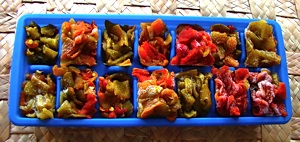 Freezing chiles is an excellent way of preserving them. Chiles that have been frozen retain all the characteristics of fresh chiles except for their texture. Since the individual cell walls have been ruptured by the freezing of the water within each cell, the chiles will lose their crisp texture.
Freezing chiles is an excellent way of preserving them. Chiles that have been frozen retain all the characteristics of fresh chiles except for their texture. Since the individual cell walls have been ruptured by the freezing of the water within each cell, the chiles will lose their crisp texture.
Another result of the freezing process, according to one source, is to spread the capsaicin throughout the chile. This occurs with the rupturing of the cell walls and can actually make some chiles seem hotter after freezing than they were beforehand. Research to date indicates that freezing chiles does not actually make them hotter. There is simply nothing that the freezing process alone can do, either physically or chemically, to increase the heat of a chile.
There are different requirements for freezing chiles, depending on the size of the chile. Large chiles may be frozen at any stage once they have been roasted. That is, they may be frozen before peeling (freezing actually makes them easier to peel), or after peeling and de seeding. They may be frozen whole or chopped.
The easiest way to freeze large chiles is to put them into freezer bags, double-bag them and place in the freezer. You can also wrap them in heavy foil or freezer wrap, or you can pack them in rigid plastic containers. A handy way to freeze chopped New Mexico green chile is in plastic ice cube trays. After the trays are frozen, the chile cubes can be popped out and stored in bags. The cubes can then be used when making soups or stews, or in other recipes, without having to pry apart blocks of frozen chiles.
Smaller varieties, including habaneros, serranos, jalapeños, and Thai chiles can be frozen without processing. Just wash off the chiles and allow them to dry before freezing. Then place them on a cookie sheet or other flat surface, one layer deep, and put them in the freezer until frozen solid. They can then be stored in double freezer bags and will keep for nine to twelve months at zero degrees F. Sometimes they dry out a bit and need to be soaked in water during defrosting to rehydrate them. When chopped into a salsa, for example, few people can tell that they have been frozen. Some sources call for blanching fresh peppers first, but in our experience, this step is not necessary.
Fresh red chile paste can be stored in plastic containers or zip bags and frozen to use all year long. The paste holds up well in the freezer and really helps to cut meal preparation time.
I stole this from our sister, Burn Central. To see it and more ways to preserve your chile harvest, check out the original article here.– Editor Masker
Latest posts by Dave DeWitt (see all)
- Enchiladas Verdes con Chile Pasado - 02/08/2023
- Smoked Oysters with Ancho Chile Sauce - 01/13/2023
- Machaca Sierra Madre - 01/11/2023







